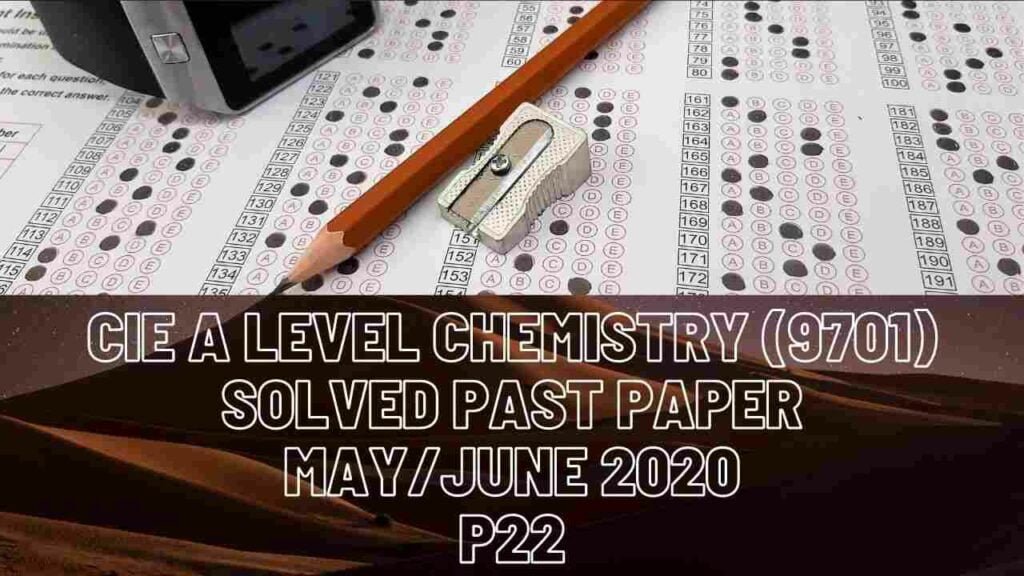
CIE A Level Chemistry Solved Past Paper May/June 2020 P22
1c) Gallium has an electron configuration of 1s2 2s2 2p6 3s2 3p6 4s2 3d10 4p1: lowest energy level is the one which is nearest to the atom’s nucleus and that is s subshell of quantum shell 1. Highest energy level is in quantum shell 4 and has p subshell with only 1 electron.
d) All electrons carry the same negative charge and electron pair surrounding the central atom in molecule repel other electron pairs in the same molecule. This repulsion causes separation in electron pairs until these repulsive forces are minimalized. Repulsion experience by 2 lone pair of electrons is the greatest and that between 2 bonded pair of electrons is the least. Gallium has 3 electrons in its outermost shell and 3 chlorine atoms bond to 1 gallium atom; this means that all 3 electrons of gallium atom bond contribute to bonds with 3 chlorine atoms. There are no lone pair of electrons surrounding gallium in GaCl3 thus repulsion is same for each pair of electrons.
2b) Nitrogen has 5 electrons in its outermost shell and 3 of them are shared with 3 hydrogen atoms. This leaves a lone pair of electrons causing unequal repulsion between pair of electrons. Bonded pair of electrons will have less repulsion amongst themselves but that with lone pair of electrons is going to be greater.
e) In this kind of Q, convert everything to moles then look for that one substance which is common in both Stage 3 reaction equation and in formation of ammonium nitrate equation. Its HNO3 so considering mole ratio of it with NO2 since the Q is saying that same amount of HNO3 which was produced in Stage 3 was used in formation of ammonium nitrate, you can can calculate volume of NO2 used.
3b) Glucose & Fructose, both have 12 carbon, 22 hydrogen and 11 oxygen atoms but these atoms are differently arranged; this makes them structural isomers of each other. They are not just functional group isomers but positional isomers too. Glucose has aldehyde group at the end of chain while fructose has ketone group in the middle of chain.
ci) Reaction A speeds up on addition of enzyme and achieves a lower activation energy which is of reaction B too. This means reaction A initially had a much higher activation energy.
ii) Enzymes are biological catalysts which speed up a reaction by lowering ONLY activation energy, this change doesn’t alter enthalpy of reaction.
iii) First and foremost, your enthalpy of reaction is negative thus your products are going to have a lower energy than reactants. Secondly, activation energy is higher in magnitude than enthalpy of the reaction ( 29kJ/mol>14kJ/mol) means your hump in graph which represents activation energy will be bigger in size than the difference between reactants’ and products’ energy.
dii) Enthalpy for combustion of sucrose is energy required to combusts 1 mole of sucrose in oxygen. Here 1g of sucrose burns and energy released will be equal to energy required to burn that 1g of sucrose. Energy released can be calculated by using the formula E=m*c*temp.change where m in this Q is the mass of amount of water whose temperature is being raised, c is the specific heat capacity of water and temp.change is from 25°C to 40.7°C.
4 ai)
| Ion | silver nitrate solution | dilute NH3 | concentrated NH3 |
| Chloride | white | dissolves | dissolves |
| Bromide | cream | insoluble | dissolves |
| Iodide | yellow | insoluble | insoluble |
bii) SN2 mechanisms indicate that the structure has an intermediate product which is primary carbocation. Primary carbocations are least stable and do not have enough positive inductive effect of alkyl groups to form as intermediates due to less alkyl groups near C-X bond.
civ) Methylpropene has C=C with one C having 2 H atoms on its side and the other C atom having 2 methyl groups attached to it. This means Cl is either on first or second C atom.
5a) Alkene + water ———> alcohol (type of reaction: hydration & type of mechanism: electrophilic addition).
Primary alcohol + acidified KMnO4/K2Cr2O7 [reflux]———> carboxylic acid
Primary alcohol + acidified KMnO4/K2Cr2O7 [distill]———-> aldehyde
bi) 1st step: C=O breaks heterolytically with C taking partial positive charge and O taking partial negative charge due to being more electronegative than C. Partial positive charge on C attracts C?N–
2nd step: C of C=O has now complete valency after bonding with C?N but O from C-O has a negative charge plus lone pair of electrons which attracts H from H-C?N when this bond also breaks heterolytically, H taking partial positive charge and C?N taking partial negative charge.
c) Product of reaction 3 has got secondary alcohol and nitrile group. Nitrile group changes to -COOH group on addition of H2O+HCl(any strong acid). This doesn’t affect secondary alcohol group.